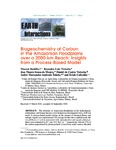Please use this identifier to cite or link to this item:
http://www.alice.cnptia.embrapa.br/alice/handle/doc/879705| Title: | Biogeochemistry of carbon in the Amazonian Floodplains over a 2000-km reach: insights from a process-based model. |
| Authors: | BUSTILLO, V.  VICTORIA, R. L.   MOURA, J. M. S. de   VICTORIA, D. de C.   COLICCHIO, E.   |
| Affiliation: | VICENT BUSTILLO, CENA/USP; REYNALDO LUIZ VICTORIA, CENA/USP; JOSÉ MAURO SOUSA DE MOURA, Universidade Federal do Oeste do Pará; DANIEL DE CASTRO VICTORIA, CNPM; ERICH COLICCHIO, UFT. |
| Date Issued: | 2011 |
| Citation: | Earth Interactions, Washington, v. 15, n. 4, p. 1-29, 2011. |
| Description: | The influence of Amazonian floodplains on the hydrological, sedimentary, and biogeochemical river budget was investigated over a 2000-km reach. A process-based model relying on the closure of chemical fluxes and isotopic signals was implemented. On average for the whole studied reach, the overall fluxes of carbon associated with mineralization and aquatic photosynthesis were estimated to 35.7 and 15.3 Tg C yr21, respectively. Almost 57% of the carbon sequestrated by photosynthesis comes from aerial sources (flooded forest); the remaining 43% resulted from aquatic sources (va´rzea grasses and phytoplankton). The process rates substantially fluctuate over the annual cycle, depending particularly on the extension of flooded area and on the river?floodplain connectivity. As the river level declines, the drastic decrease of turbidity and the lower supply of carbon substrates promote autotrophy to the detriment of heterotrophy, leading to substantial changes of pH and gaseous equilibria in the river water. The main consequences are (i) the side-chain oxidation of dissolved organic matter leading to the concomitant rises of the carbon to nitrogen atomic ratio and nitrate contents and (ii) the sorption of hydrophobic humic acids, which fractionate 13C and thus lead to 13C-depleted particulate organic matter (fine fraction) compared to remaining dissolved organic matter. As the river flow rises, the heterotrophy prevails over autotrophy and this tends to attenuate the chemical signature imprinted by the latter. The significant contribution of aerial autochthonous sources to the budget of carbon indicates that the fluxes of mineralization are sustained by the net primary production of river corridors. The variable extension of submerged areas defines the proportions of CO2 exported by the river and released to the atmosphere. The rate of CO2 outgassing on the studied reach (18.8 Tg C yr21) represents about 50% of the incoming dissolved inorganic carbon flux. The rate of methane emission is estimated as 2.2 Tg C yr21 and that of denitrification is estimated as 0.87 Tg N yr21, representing 1.5 times the flux of dissolved inorganic nitrogen (DIN) exported by the Amazon River at the station of O ´ bidos (0.64 Tg N yr21). |
| NAL Thesaurus: | Amazon River floodplains carbon biogeochemical cycles |
| Keywords: | CO2 outgassing |
| DOI: | 10.1175/2010EI338.1 |
| Type of Material: | Artigo de periódico |
| Access: | openAccess |
| Appears in Collections: | Artigo em periódico indexado (CNPM)  |
Files in This Item:
| File | Description | Size | Format | |
|---|---|---|---|---|
| biogeochemistry.pdf | 2.19 MB | Adobe PDF |  View/Open |









